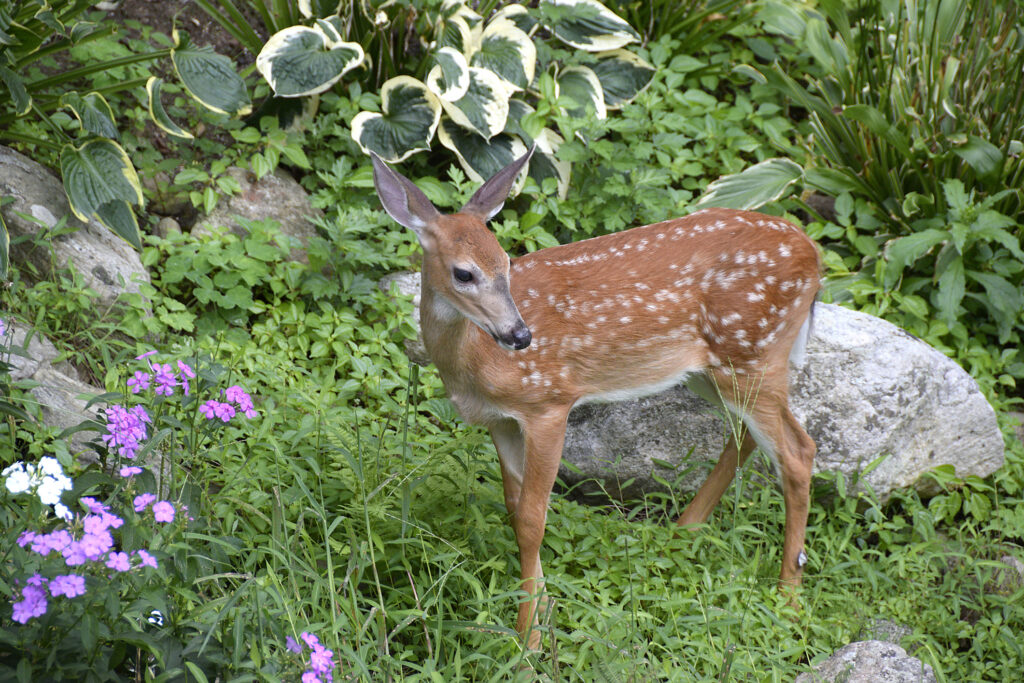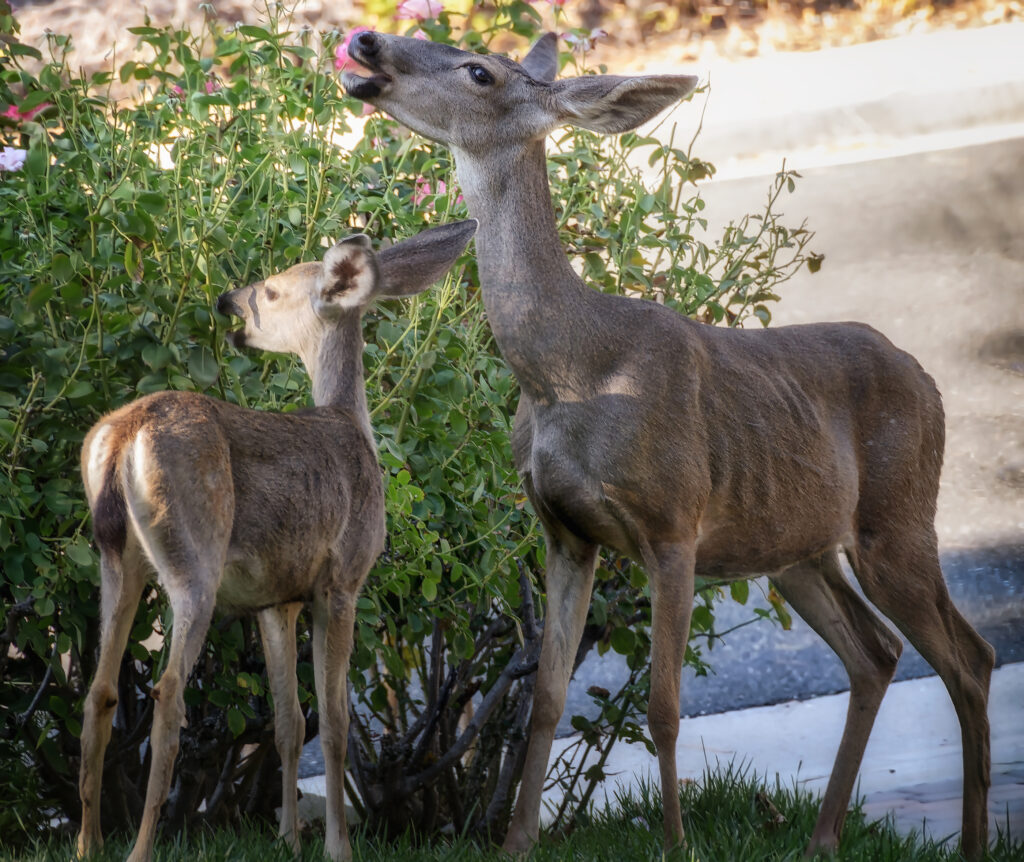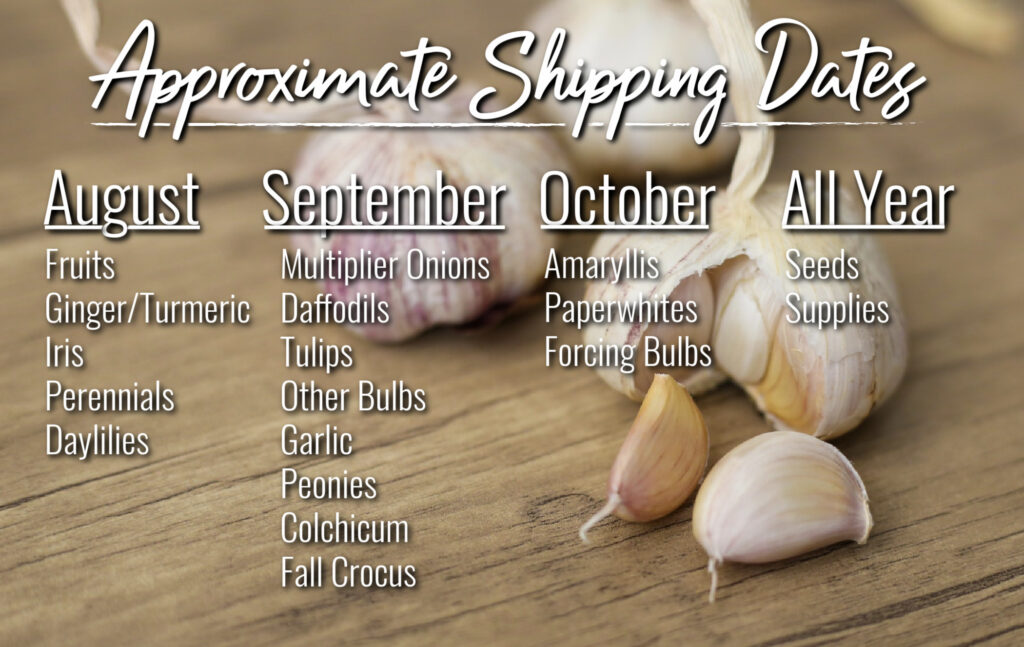
When you stop and contemplate how amazingly successful and adaptive deer have been in our urban environments, you have to simply admire them. They are even more adaptive than we are. The first element for us to recognize is that our homes, neighborhoods, and developments have encroached on their habitats and not the other way around.
Deer are not coming into our yards because they like our company, they are searching for a tasty meal that we’ve unintentionally provided. We, as gardeners and indeed humans, are forced into the awkward and embarrassing position of having to become smarter than they are to reduce their impact on our personal space. This is not impossible if we stop, pay attention, learn, and adapt to what their needs and habits are.

It is critical to understand that this is a simple cause and effect scenario. A deer eating plants in our garden is the effect, so then, what is the cause? The cause is most frequently, a delicious tasting plant, a suitable habitat, or possibly just a browsing corridor. If these “causes” are altered, manipulated, or eliminated the deer will simply go elsewhere.
Reducing deer impact on our gardens can be as simple as planting resistant plants but usually, additional efforts must be applied depending on the severity of the winter, deer populations, and hunting management in your local area. Increased hunting has been shown to actually increase deer populations. To avoid a deer disaster in your garden, adopt the following tactics.
Four Ways To Keep Deer Out Of Your Garden

- Plant resistant plants
- Don’t plant, or eliminate their favorite plant foods
- Repellents
- Erect physical barriers (fencing)
Later in this article, you will find a list of options of resistant plants and a list of “favorite” plants to avoid but first here is some valuable information about using repellents.
Deer Repellents

Deer are browsers, which means their diet consists of many different plants. They will taste everything and anything to test its palatability. Yearlings are especially fond of tasting newly planted plants, to satisfy their curiosity. Repellents are meant to interrupt or prevent deer from browsing on plants. Repellents can be spray form, granular, or sachets to hang.
Repellents are behavior modification tools
Does Deer Repellent Keep Deer Away?
Effectiveness of repellents will depend on many factors; availability of food sources, seasonal changes in plant palatability, local deer preferences and nutrition, time of year, and how many deer are feeding in a particular area – this is referred to as “pressure”. Deterrence with repellents in high-pressure populations may not be the best solution, fencing is a more reasonable option.
How Does Deer Repellent Work?
Repellents are designed to do just that, repel. They can do this in three main ways:
- Fear repellent – sulfur or ammonia scents are associated with predators (Shake Away Coyote Urine Granules & Liquid Fence®)
- Adverse taste or smell – bitter or foul flavors (Fend Off® Deer/Rabbit & Critter Ridder®)
- Pain inducing – hot pepper as in capsaicin (Hot Pepper Wax™)

When Should I Apply Deer Repellent?
For repellents to be most effective they should be applied early and often. Winter, when food is scarce, is an excellent time to spray repellents and early in the season, after the snow melts prior to bud-break. If rainfall washes off what you sprayed, go spray again.
Tips For Using Deer Repellents
- Make spraying as routine as fertilizing or watering.
- Rotate two or more products to keep the deer confused and guessing.
- Maintain proper spray height of 2 ft. to 6 ft. in height.
Again, you are not trying to break a browsing habit, as much as trying to prevent one from forming in the first place. Consistency with repellents works best to cause the animals to form a negative association with your plants and garden in general.
Deer Repellent Plants

Deer resistant plants do not mean the deer won’t eat them, but they are less likely to do so. Click here for the list of deer repellent plants including annuals, perennials, groundcover, ornamental grass, shrubs, and bulbs that are deer resistant.
Plants That Attract Deer

Avoid planting these plants if you live in a deer populated area.
- Daylily
- Garden Phlox
- Grape Hyacinth
- Hosta spp.
- Hollyhocks
- Impatiens
- Jerusalem artichoke
- Lilies
- Roses
- Sunflowers
- Stock
- Trillium
- Tulips
- Violas
- Wallflower
Deer do not want to destroy your garden, they are just hungry and looking for a tasty meal. Living with deer becomes easier when you know what to plant and what not to plant. Knowing what repellents to use, and how to use them successfully will make viewing a doe and her precious fawns more enjoyable when you have some resources like these to carefully and caringly help move deer off your property to feed in another field or forest.

Find all your gardening needs at Jung Seed Co. A family-owned and operated company in Wisconsin. Respected for quality and service since 1907.
